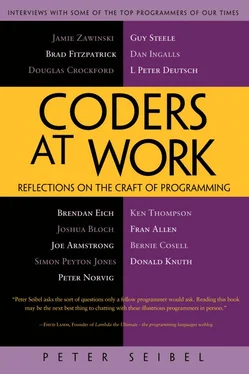Peter Seibel - Coders at Work - Reflections on the craft of programming
Здесь есть возможность читать онлайн «Peter Seibel - Coders at Work - Reflections on the craft of programming» весь текст электронной книги совершенно бесплатно (целиком полную версию без сокращений). В некоторых случаях можно слушать аудио, скачать через торрент в формате fb2 и присутствует краткое содержание. Жанр: Программирование, на английском языке. Описание произведения, (предисловие) а так же отзывы посетителей доступны на портале библиотеки ЛибКат.
- Название:Coders at Work: Reflections on the craft of programming
- Автор:
- Жанр:
- Год:неизвестен
- ISBN:нет данных
- Рейтинг книги:3 / 5. Голосов: 1
-
Избранное:Добавить в избранное
- Отзывы:
-
Ваша оценка:
- 60
- 1
- 2
- 3
- 4
- 5
Coders at Work: Reflections on the craft of programming: краткое содержание, описание и аннотация
Предлагаем к чтению аннотацию, описание, краткое содержание или предисловие (зависит от того, что написал сам автор книги «Coders at Work: Reflections on the craft of programming»). Если вы не нашли необходимую информацию о книге — напишите в комментариях, мы постараемся отыскать её.
Coders at Work
Founders at Work
Coders at Work: Reflections on the craft of programming — читать онлайн бесплатно полную книгу (весь текст) целиком
Ниже представлен текст книги, разбитый по страницам. Система сохранения места последней прочитанной страницы, позволяет с удобством читать онлайн бесплатно книгу «Coders at Work: Reflections on the craft of programming», без необходимости каждый раз заново искать на чём Вы остановились. Поставьте закладку, и сможете в любой момент перейти на страницу, на которой закончили чтение.
Интервал:
Закладка:
Erlang’s quite well suited there because the programmer has said, “I want a process, I want another process, I want another process.” Then we just put them on the cores. And maybe we should be thinking about actually physically placing them on cores. Probably a process that spawns another process talks to that process. So if we put it on a core that’s physically near, that’s a good place to put it, not on one that’s a long way away. And maybe if we know it’s not going to talk to it a lot maybe we can put it a long way away. And maybe processes that do I/O should be near the edge of the chip—the ones that talk to the I/O processes. As the chips get bigger we’re going to have to think about how getting data to the middle of the chip is going to cost more than getting it to the edge of the chip. Maybe you’ve got two or three servers and a database and maybe you’re going to map this onto the cores so we’ll put the database in the middle of the chip and these ones talk to the client so we’ll put them near the edge of the chip. I don’t know—this is research.
Seibel:You care a lot about the idea of Erlang’s way of doing concurrency. Do you care more about that idea—the message-passing shared-nothing concurrency—or Erlang the language?
Armstrong:The idea—absolutely. People keep on asking me, “What will happen to Erlang? Will it be a popular language?” I don’t know. I think it’s already been influential. It might end up like Smalltalk. I think Smalltalk’s very, very influential and loved by an enthusiastic band of people but never really very widely adopted. And I think Erlang might be like that. It might need Microsoft to take some of its ideas and put some curly braces here and there and shove it out in the Common Language Runtime to hit a mass market.
Simon Peyton Jones
One of the instigators, back in 1987, of the project that led to the definition of the programming language Haskell, Simon Peyton Jones is a Principal Researcher at Microsoft Research’s lab in Cambridge, England. He edited the Haskell 98 Revised Report , the current stable definition of the language; he is the architect and lead developer of the Glasgow Haskell Compiler (GHC), the “de facto standard compiler” according to haskell.org; and he gave Haskell its widely cited unofficial motto: “Avoid success at all costs.”
A high-powered researcher and former professor who never got a PhD, Peyton Jones values both the practical and the theoretically beautiful. He learned to program on a machine with no permanent storage and only 100 memory locations, and in college he worked on both writing high-level compilers for the school’s big iron and building his own primitive computers out of parts he could afford on a student’s budget. But he was drawn to functional programming by a professor’s demonstration of how to build doubly linked lists without using mutation and the beauty of the idea of lazy evaluation. Peyton Jones saw the ideas of functional programming “as a radical and elegant attack on the whole enterprise of writing programs”: a way, rather than “just putting one more brick in the wall,” to “build a whole new wall.” In 2004 the Association for Computing Machinery elected him a Fellow, citing his “contributions to functional programming languages.”
Among the topics we covered in this interview are why he thinks functional programming shows increasing promise of changing the way software is written, why Software Transactional Memory is a much better way of writing concurrent software than locks and condition variables, and why it is so difficult, even at a place like Microsoft Research, to do real studies of whether different programming languages make programmers more or less productive.
Seibel:When did you learn to program?
Peyton Jones:When I was at school. Intel had just about produced the 4004—the world’s first microprocessor. We didn’t have a 4004 or anything like it—it was really a chip that hobbyists could barely get at that stage. The only computer they had available was an IBM schools computer, which was a strange machine built out of spare parts from mainframes. It had no permanent storage whatsoever so you had to type in your program every time you ran it.
It had 100 storage locations, total, which would each store, I think, eightdigit decimal numbers. And this stored both your program and your data. So the name of the game of programming that was to simply to fit the program into 100 storage locations. I can’t quite remember how I got to write my first program. I think I and one other enthusiast at the school spent a lot of time on the schools computer. This would have been when I was about 15, 1974, ’73—that kind of era.
Then after we’d been programming this machine for a little bit we discovered there was a computer at the technical college in Swindon. So we spent an hour on a very slow bus one afternoon a week and went to Swindon where there was this enormous machine—an Elliot 803—which lived in half a dozen large, white, fridge-sized cabinets in a room all its own with a white-coated operator.
After a bit the white-coated operator learned that we could figure out how to use the machine so she went away while we played with this vast engine.
It worked with paper tape and teletype so you had your program on a paper tape. We wrote in Algol, so that was my first high-level language. You wrote your program on the tape, you edited on the tape. You wanted to change it, you had to run the tape through the teletype, make it print out a new tape, stop it at the right place, type the new bit—an extremely laborious way to edit your program. A kind of line editor with physical medium. So that was my first experience of programming. It was very motivating.
Seibel:That wasn’t a course at school though.
Peyton Jones:Oh, no! Zero, absolutely no teaching about computers at school.
Seibel:So it was just—“Hey kids, here’s a computer, knock yourself out.”
Peyton Jones:Absolutely. It was there in a large locked cupboard and you could borrow the key and there it was with a screen and it just displayed a fixed display of what was in the registers and these decimal numbers of what was in memory locations. You could set the program and press Go. You could single-step it. That was really it. So it wasn’t even assembly language programming because there was no ASCII characters at all. It was literally the machine code, displayed in decimal, not even in hexadecimal.
Seibel:But it had a screen?
Peyton Jones:It did have a television screen. That was its sole output medium.
Seibel:And what was the input?
Peyton Jones:It was a kind of touch keyboard. You touched these buttons and they sensed that your finger touched. So that was rather sophisticated—no mechanical keys. It was some kind of capacitive thing—you touched the key and there it was. There were a total of about 20 buttons.
Seibel:So these buttons were just for numbers?
Peyton Jones:Numbers and Go and Step. And “show me this memory location.” It was really extremely primitive. And all the more exciting for that.
Seibel:I assume you had to plan your program, probably in excruciating detail, before you get up to this machine and start keying stuff in.
Peyton Jones:First of all you draw a flow diagram. Then you’d break it down into instructions. Then you’d encode the instructions into this strange digital format. And then you type in the numbers. You type in essentially an 800-digit number, which is your program. And then you press Go. If you were lucky you hadn’t mistyped one of those 800 digits and you were in good shape. So we spent a lot of time just looking down the thing with one guy looking at the screen and checking and the other guy saying, “Go to the next location.”
Читать дальшеИнтервал:
Закладка:
Похожие книги на «Coders at Work: Reflections on the craft of programming»
Представляем Вашему вниманию похожие книги на «Coders at Work: Reflections on the craft of programming» списком для выбора. Мы отобрали схожую по названию и смыслу литературу в надежде предоставить читателям больше вариантов отыскать новые, интересные, ещё непрочитанные произведения.
Обсуждение, отзывы о книге «Coders at Work: Reflections on the craft of programming» и просто собственные мнения читателей. Оставьте ваши комментарии, напишите, что Вы думаете о произведении, его смысле или главных героях. Укажите что конкретно понравилось, а что нет, и почему Вы так считаете.












